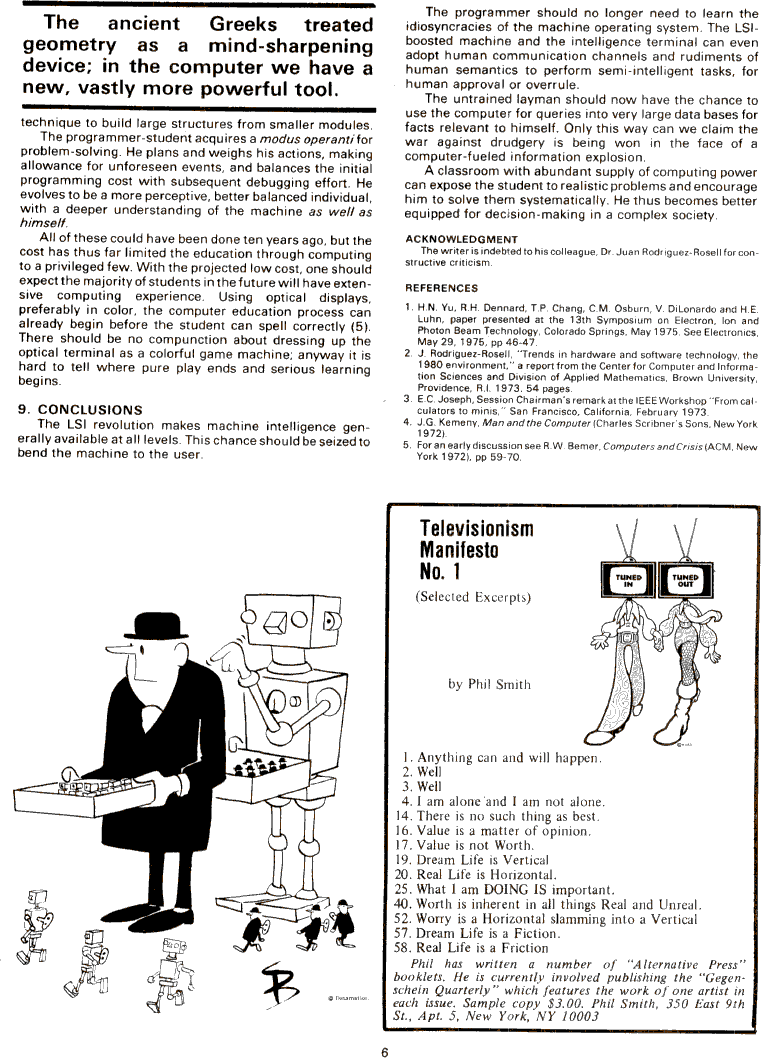by Phil Smith

_____________________________ The ancient Greeks treated geometry as a mind-sharpening device; in the computer we have a new, vastly more powerful tool. _____________________________ technique to build large structures from smaller modules. The programmer-student acquires a modus operanti for problem-solving. He plans and weighs his actions, making allowance for unforeseen events, and balances the initial programming cost with subsequent debugging effort. He evolves to be a more perceptive, better balanced individual, with a deeper understanding of the machine as well as himself. All of these could have been done ten years ago, but the cost has thus far limited the education through computing to a privileged few. With the projected low cost, one should expect the majority of students in the future will have extensive computing experience. Using optical displays, preferably in color, the computer education process can already begin before the student can spell correctly (5). There should be no compunction about dressing up the optical terminal as a colorful game machine; anyway it is hard to tell where pure play ends and serious learning begins. *** 9. CONCLUSIONS The LSI revolution makes machine intelligence generally available at all levels. This chance should be seized to bend the machine to the user. [Image] The programmer should no longer need to learn the idiosyncracies of the machine operating system. The LSIboosted machine and the intelligence terminal can even adopt human communication channels and rudiments of human semantics to perform semi-intelligent tasks, for human approval or overrule. The untrained layman should now have the chance to use the computer for queries into very large data bases for facts relevant to himself. Only this way can we claim the war against drudgery is being won in the face of a computer-fueled information explosion. A classroom with abundant supply of computing power can expose the student to realistic problems and encourage him to solve them systematically. He thus becomes better equipped for decision-making in a complex society. *** ACKNOWLEDGMENT The writer is indebted to his colleague, Dr Juan Rodriguez-Rosell for constructive criticism. *** REFERENCES 1. H.N. Yu, R.H. Dennard, T.P. Chang, C.M. Osburn, V. DiLonardo and H.E Luhn, paper presented at the 13th Symposium on Electron, Ion and Photon Beam Technology, Colorado Springs, May 1975. See Electronics, May 29, 1975, pp 46-47. 2. J. Rodriguez-Rosell, "Trends in hardware and software technology, the 1980 environment," a report from the Center for Computer and Information Sciences and Division of Applied Mathematics, Brown University, Providence, R.I. 1973. 54 pages. 3. E.C. Joseph, Session Chairman's remark at the IEEE Workshop "From calculators to minis," San Francisco, California, February 1973. 4. J.G. Kemeny, Man and the Computer (Charles Scribner's Sons, New York 1972). 5. For an early discussion see R.W. Bemer, Computers and Crisis (ACM, New York 1972), pp 59-70. [Image] Television Manifesto No.1 (Selected Excerpts) by Phil Smith 1. Anything can and will happen. 2. Well 3. Well 4. I am alone and l am not alone. 14. There is no such thing as best. 16. Value is a matter of opinion. 17. Value is not Worth. 19. Dream Life is Vertical 20. Real Life is Horizontal. 25. What l am DOING lS important. 40. Worth is inherent in all things Real and Unreal. 52. Worry is a Horizontal slamming into a Vertical 57. Dream Life is a Fiction. 58. Real Life is a Friction Phil has written a number of "Alternative Press" booklets. He is currently involved publishing the "Gegenschein Quarterly" which features the work of one artist in each issue. Sample copy $3.00. Phil Smith, 350 East 9th St., Apt. 5, New York, NY 10003

